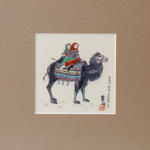Kato Takuo 加藤卓男 1917-2005
In the Kavir desert, Iran イラン・カヴィール砂漠の中で
Original Painting
Image:
H3.7 × W3.7in.
H9.3 × W9.3 cm
Frame:
H11.5 × W12.2 in.
H29.2 × W30.9 cm
H3.7 × W3.7in.
H9.3 × W9.3 cm
Frame:
H11.5 × W12.2 in.
H29.2 × W30.9 cm
Sold
Kato Takuo was a renowned Japanese ceramic artist and the sixth-generation head of the Kōbē Kiln. Born into a family of pottery masters dating back to the late Edo period,...
Kato Takuo was a renowned Japanese ceramic artist and the sixth-generation head of the Kōbē Kiln. Born into a family of pottery masters dating back to the late Edo period, he was first trained in the ceramic arts by his father, Kato Kobei, before going on to study at the Kyoto School of Ceramics. In 1965, he also traveled to Finland to continue his studies. Afterwards, he became fully immersed in the Kyoto pottery scene. He is most celebrated for reviving the ancient technique of Lusterware, a type of pottery known for its metallic glaze that resembles gold. This technique originated in ancient Persia (modern-day Iran) and had disappeared around the 18th century.
In 1961, during his first visit to Iran, Kato became captivated by the beauty of traditional Persian ceramics, particularly Lusterware. He discovered that the technique for creating this unique pottery had been lost for centuries, which deeply moved him. Determined to revive it, Kato made frequent trips to Iran, collecting samples, consulting with experts, and studying ancient kiln sites. His dedication led him to the discovery of detailed records on Lusterware left by Arthur Upham Pope, a prominent scholar of Persian art.
Among his ceramic styles, Kato is most famous for his Sancai porcelain production, a medium that has a long history of export and trade over lands, seas, and across time. Kato’s commitment to history and revival of medieval pottery styles, and Mino pottery styles earned him the designation of a Bearer of Intangible Cultural Heritage (colloquially, Living National Treasure) in 1995. His research into Persian lustreware and historical Chinese glaze styles has since been passed down to his son, the seventh-generation head of the Kōbē Kiln, Kato Kōbē.
This painting depicts two children sitting on a camel traversing the Kavir desert in Iran: Kato was inspired by the medieval silk road route, which involved what was sure to be a long journey across the Kavir desert.
In 1961, during his first visit to Iran, Kato became captivated by the beauty of traditional Persian ceramics, particularly Lusterware. He discovered that the technique for creating this unique pottery had been lost for centuries, which deeply moved him. Determined to revive it, Kato made frequent trips to Iran, collecting samples, consulting with experts, and studying ancient kiln sites. His dedication led him to the discovery of detailed records on Lusterware left by Arthur Upham Pope, a prominent scholar of Persian art.
Among his ceramic styles, Kato is most famous for his Sancai porcelain production, a medium that has a long history of export and trade over lands, seas, and across time. Kato’s commitment to history and revival of medieval pottery styles, and Mino pottery styles earned him the designation of a Bearer of Intangible Cultural Heritage (colloquially, Living National Treasure) in 1995. His research into Persian lustreware and historical Chinese glaze styles has since been passed down to his son, the seventh-generation head of the Kōbē Kiln, Kato Kōbē.
This painting depicts two children sitting on a camel traversing the Kavir desert in Iran: Kato was inspired by the medieval silk road route, which involved what was sure to be a long journey across the Kavir desert.



